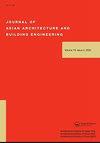历史街区文化基因的识别及其对文化感知的影响--哈尔滨中央大街案例研究
IF 1.6
4区 工程技术
0 ARCHITECTURE
Journal of Asian Architecture and Building Engineering
Pub Date : 2024-06-30
DOI:10.1080/13467581.2024.2373823
引用次数: 0
摘要
历史街区的文化基因是城市文化遗产的重要载体,也是人们感知城市文化遗产的主要方式。在本研究中,文化感知与历史街区文化基因之间的关系是研究的重点。本文章由计算机程序翻译,如有差异,请以英文原文为准。
The identification of cultural genes in historic districts and their influences on cultural perception—case study in Central Street in Harbin, China
Cultural genes in historic districts are an important carrier of, and the main way in which people perceive, urban cultural heritage. In this study, the relationship between cultural perception and...
求助全文
通过发布文献求助,成功后即可免费获取论文全文。
去求助
来源期刊
CiteScore
2.20
自引率
15.40%
发文量
127
审稿时长
9 months
期刊介绍:
Journal of Asian Architecture and Building Engineering is a refereed international Open Access journal, serving researchers in academic and research organizations and all practitioners in the building sector. The journal is jointly-edited by the Architectural Institute of Japan (AIJ), the Architectural Institute of Korea (AIK), and the Architectural Society of China (ASC) and published bi-monthly.
Asian academics and professionals have made efforts to find solutions to the themes derived from natural, geographical, socio-economical and cultural conditions in Asia. Their achievements have contributed to the evolution of research in the field of architecture and building engineering. For instance, achievements in structural engineering have contributed to the world by developing technology to assure safety of buildings in earthquake-prone areas.
Asia has the largest share of the world''s population with high densities in urban areas. It is a growing and the most energetic region in terms of building activities, which produces valuable empirical knowledge and lessons to architects and building engineers in Asia. It is quite significant to contribute to global architecture and building engineering by presenting the knowledge and lessons beyond linguistic barriers.
By publishing the journal in English, it is expected that Asian wisdom and experience will be disseminated to the world. In the countries where these institutions are based, building professions can enjoy the collaborative and holistic approach because the three institutions distinctively possess the whole range of expertise relating to architecture and building engineering.

 求助内容:
求助内容: 应助结果提醒方式:
应助结果提醒方式:


